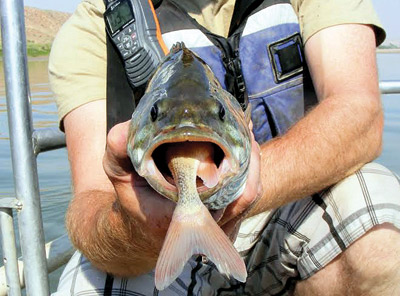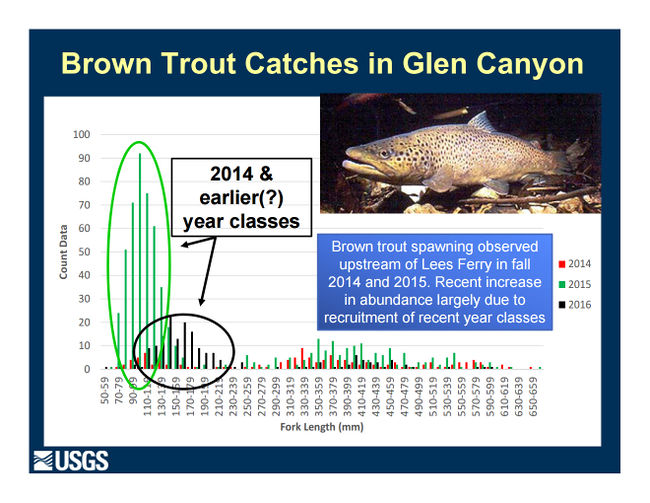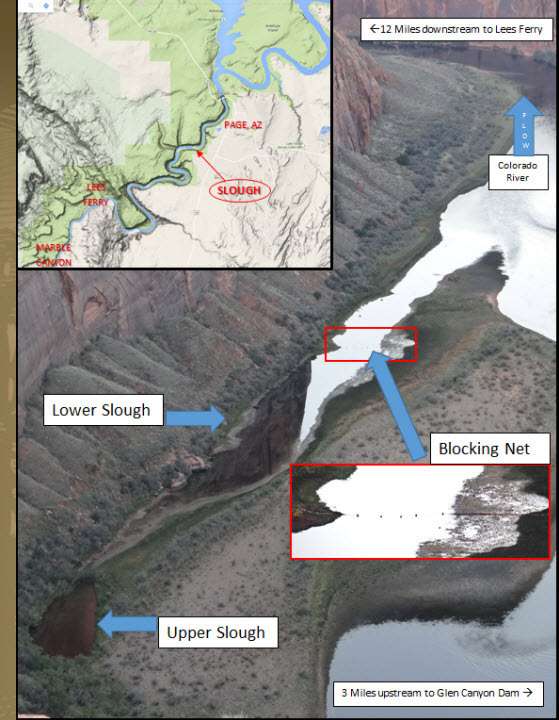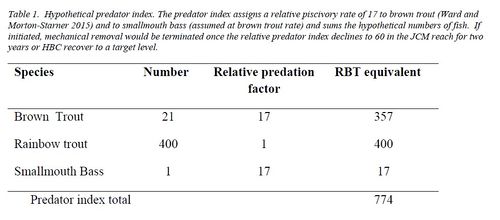Difference between revisions of "Nonnative Invasive Aquatic Species"
Cellsworth (Talk | contribs) |
Cellsworth (Talk | contribs) |
||
| Line 46: | Line 46: | ||
[http://gcdamp.com/index.php?title=Brown_Trout '''Brown trout'''] and [http://gcdamp.com/index.php?title=Green_Sunfish_Page '''green sunfish'''] have recently established themselves in Glen Canyon raising concerns for management of endangered fish like [http://gcdamp.com/index.php?title=Humpback_Chub_Page '''humpback chub'''] further downstream. <br> | [http://gcdamp.com/index.php?title=Brown_Trout '''Brown trout'''] and [http://gcdamp.com/index.php?title=Green_Sunfish_Page '''green sunfish'''] have recently established themselves in Glen Canyon raising concerns for management of endangered fish like [http://gcdamp.com/index.php?title=Humpback_Chub_Page '''humpback chub'''] further downstream. <br> | ||
| − | [[File:BrownTrouSizetLeesFerry_USGS2016.jpg|center|650px | + | [[File:BrownTrouSizetLeesFerry_USGS2016.jpg|thumb|center|650px| [https://www.usbr.gov/uc/progact/amp/amwg/2016-08-24-amwg-meeting/Attach_07a.pdf https://www.usbr.gov/uc/progact/amp/amwg/2016-08-24-amwg-meeting/Attach_07a.pdf] ]] |
[[file:Slough.jpg|center|px500]] <br> | [[file:Slough.jpg|center|px500]] <br> | ||
| Line 87: | Line 87: | ||
Found primarily in tributaries of the Colorado River in Grand Canyon. A small cylindrical, minnow-like fish with black vertical bars. Maximum size about 5 inches. Killifish are known as “topminnows” because of their habit of skimming along just beneath the surface of the water feeding on insects and other small invertebrates. The top of the head and forward part of the back are broad and flat and the mouth is tilted upward so that it opens at the upper surface of the head to facilitate surface feeding. The species is easily distinguished by the presence of a seemingly massive protruding lower jaw with many teeth, thus the name “cyprinodont” which means “toothed carp”. Plains killifish, (Fundulus zebrinus) and plains topminnow (Fundulus sciadicus) are reported as incidental in the Colorado, Green, and White Rivers of the upper basin, and rare in the San Juan River. The plains killifish has a dorsal fin base situated above or forward of the anal fin base; usually 13 to 16 dorsal fin rays; 40 or more lateral line scales; and 12 to 13 dark vertical bars on the sides of the body. The plains topminnow has a dorsal fin base situated above the anal fin base; usually 6 to 11 dorsal fin rays; 38 or fewer lateral line scales; and without vertical bars or horizontal streaks. Plains killifish may compete with small native fishes for food. | Found primarily in tributaries of the Colorado River in Grand Canyon. A small cylindrical, minnow-like fish with black vertical bars. Maximum size about 5 inches. Killifish are known as “topminnows” because of their habit of skimming along just beneath the surface of the water feeding on insects and other small invertebrates. The top of the head and forward part of the back are broad and flat and the mouth is tilted upward so that it opens at the upper surface of the head to facilitate surface feeding. The species is easily distinguished by the presence of a seemingly massive protruding lower jaw with many teeth, thus the name “cyprinodont” which means “toothed carp”. Plains killifish, (Fundulus zebrinus) and plains topminnow (Fundulus sciadicus) are reported as incidental in the Colorado, Green, and White Rivers of the upper basin, and rare in the San Juan River. The plains killifish has a dorsal fin base situated above or forward of the anal fin base; usually 13 to 16 dorsal fin rays; 40 or more lateral line scales; and 12 to 13 dark vertical bars on the sides of the body. The plains topminnow has a dorsal fin base situated above the anal fin base; usually 6 to 11 dorsal fin rays; 38 or fewer lateral line scales; and without vertical bars or horizontal streaks. Plains killifish may compete with small native fishes for food. | ||
| − | © 1993 Written by Richard A. Valdez, Ph.D. BIO/WEST Illustrated by M. C. Filbert Produced by Grand Canyon River Guides, Inc. Additional copies available for $3 each or 2 for $5, postpaid, from: GCRG, P.O. Box 1934, Flagstaff, AZ 86002. (602) 773-1075 | + | [http://www.gcrg.org/bqr/6-4/fishes.htm © 1993 Written by Richard A. Valdez, Ph.D. BIO/WEST Illustrated by M. C. Filbert Produced by Grand Canyon River Guides, Inc. Additional copies available for $3 each or 2 for $5, postpaid, from: GCRG, P.O. Box 1934, Flagstaff, AZ 86002. (602) 773-1075] |
<!-- | <!-- | ||
| Line 129: | Line 129: | ||
|style="color:#000;"| | |style="color:#000;"| | ||
| − | *[https://www.usbr.gov/uc/ | + | *[https://www.usbr.gov/uc/progact/amp/amwg/2012-02-22-amwg-meeting/FINAL%20NNFC%20EA%20with%20Appendices/Appendix_A_SDM%20Report.pdf Appendix A: Non-native Fish Control SDM Report] |
| − | *[https://www.usbr.gov/uc/ | + | *[https://www.usbr.gov/uc/progact/amp/amwg/2012-02-22-amwg-meeting/FINAL%20NNFC%20EA%20with%20Appendices/Appendix_B_SciencePlan.pdf Appendix B: Non-native Fish Control Science Plan] |
| − | *[https://www.usbr.gov/uc/ | + | *[https://www.usbr.gov/uc/progact/amp/amwg/2012-02-22-amwg-meeting/FINAL%20NNFC%20EA%20with%20Appendices/Appendix_C_BA.pdf Appendix C: Non-native Fish Control BA] |
| − | *[https://www.usbr.gov/uc/ | + | *[https://www.usbr.gov/uc/progact/amp/amwg/2012-02-22-amwg-meeting/FINAL%20NNFC%20EA%20with%20Appendices/Appendix_D_Supp.pdf Appendix D: Non-native Fish Control BA Supplement] |
| − | *[https://www.usbr.gov/uc/ | + | *[https://www.usbr.gov/uc/progact/amp/amwg/2012-02-22-amwg-meeting/FINAL%20NNFC%20EA%20with%20Appendices/Appendix_E_BO.pdf Appendix E: Biological Opinion] |
| − | *[https://www.usbr.gov/uc/ | + | *[https://www.usbr.gov/uc/progact/amp/amwg/2012-02-22-amwg-meeting/FINAL%20NNFC%20EA%20with%20Appendices/NNFC_EA_12-30-11.pdf Appendix F: SHPO Letter] |
|- | |- | ||
| Line 153: | Line 153: | ||
'''2018''' | '''2018''' | ||
*[http://www.bioone.org/doi/10.1674/0003-0031-180.1.119 Stone et al., 2018, Abiotic Controls of Invasive Nonnative Fishes in the Little Colorado River, Arizona. The American Midland Naturalist] | *[http://www.bioone.org/doi/10.1674/0003-0031-180.1.119 Stone et al., 2018, Abiotic Controls of Invasive Nonnative Fishes in the Little Colorado River, Arizona. The American Midland Naturalist] | ||
| − | *[https://www.usbr.gov/uc/ | + | *[https://www.usbr.gov/uc/progact/amp/twg/2018-01-25-twg-meeting/AR15.pdf Invasives and other Non-Native aquatic species of the Lees Ferry Reach of the Colorado River PPT] |
'''2017''' | '''2017''' | ||
*[https://doi.org/10.1016/j.biocon.2018.01.032 Bair et al., 2018, Identifying cost-effective invasive species control to enhance endangered species populations in the Grand Canyon, USA: Biological Conservation ] | *[https://doi.org/10.1016/j.biocon.2018.01.032 Bair et al., 2018, Identifying cost-effective invasive species control to enhance endangered species populations in the Grand Canyon, USA: Biological Conservation ] | ||
*[[Media:USFWS 2017 Invasive Species Surveys Final Report.pdf| Aquatic Invasive Species Surveillance in the Little Colorado River Basin]] | *[[Media:USFWS 2017 Invasive Species Surveys Final Report.pdf| Aquatic Invasive Species Surveillance in the Little Colorado River Basin]] | ||
| − | *[https://www.usbr.gov/uc/ | + | *[https://www.usbr.gov/uc/progact/amp/twg/2017-01-26-twg-meeting/AR21_Rogowski.pdf System Wide Monitoring ] |
'''2015''' | '''2015''' | ||
*[https://drive.google.com/file/d/0BwY-Z2c3NTUGQS1DbWY4RWo2TWc/view GCMRC Science Updates - Fisheries] | *[https://drive.google.com/file/d/0BwY-Z2c3NTUGQS1DbWY4RWo2TWc/view GCMRC Science Updates - Fisheries] | ||
| − | *[ | + | *[https://www.usbr.gov/uc/progact/amp/twg/2015-01-20-twg-meeting/Attach_10.pdf Native and Nonnative Interactions; Factors Influencing Predation and Competition] |
'''2014''' | '''2014''' | ||
| − | *[ | + | *[https://www.usbr.gov/uc/progact/amp/amwg/2014-08-27-amwg-meeting/Attach_04b.pdf Status of Fish Resources ] |
| − | *[ | + | *[https://www.usbr.gov/uc/progact/amp/amwg/2014-02-19-amwg-meeting/Attach_13.pdf National Park Service Comprehensive Fisheries Management Plan ] |
| − | *[ | + | *[https://www.usbr.gov/uc/progact/amp/twg/2014-01-30-twg-meeting/AR_Healy_NNFC_GRCA.pdf Non-native Fish Control in Tributaries: Grand Canyon National Park (Healy) ] |
'''2013''' | '''2013''' | ||
| − | *[https://www.usbr.gov/uc/ | + | *[https://www.usbr.gov/uc/progact/amp/amwg/2013-02-20-amwg-meeting/Attach_07b.pdf Humpback Chub and Non-native Fish Control Update ] |
'''2012''' | '''2012''' | ||
| − | *[https://www.usbr.gov/uc/ | + | *[https://www.usbr.gov/uc/progact/amp/amwg/2012-02-22-amwg-meeting/Attach_15.pdf Grand Canyon National Park Fishery Management Process and PPT] |
'''2011''' | '''2011''' | ||
| − | *[https://www.usbr.gov/uc/ | + | *[https://www.usbr.gov/uc/progact/amp/amwg/2011-05-18-amwg-meeting/Attach_06.pdf Report on Two Experimental Flow EAs: High-Flow Experimental Releases EA and Non-native Fish Control EA and PPTs] |
| − | *[https://www.usbr.gov/uc/ | + | *[https://www.usbr.gov/uc/progact/amp/twg/2011-03-08-twg-meeting/Attach_03.pdf Updates on USBR Environmental Documents PPT] |
| − | *[https://www.usbr.gov/uc/ | + | *[https://www.usbr.gov/uc/progact/amp/twg/2011-01-20-twg-meeting/Attach_04a.pdf Bureau of Reclamation Updates PPT] |
| − | *[https://www.usbr.gov/uc/ | + | *[https://www.usbr.gov/uc/progact/amp/twg/2011-01-20-twg-meeting/Attach_04c.pdf Open File Report 2011-2012, "Non-Native Fish Control Below Glen Canyon Dam--Report from a Structured Decision-Making Project] |
'''2010''' | '''2010''' | ||
| − | *[https://www.usbr.gov/uc/ | + | *[https://www.usbr.gov/uc/progact/amp/amwg/2010-08-24-amwg-meeting/Attach_13b.pdf Non-native Fish Control Environmental Assessment Update] |
| − | *[https://www.usbr.gov/uc/ | + | *[https://www.usbr.gov/uc/progact/amp/amwg/2010-02-03-amwg-meeting/Attach_09a.pdf Non-native Fish Control Planning with Nonnative Fish Control in Grand Canyon-Historical Perspectives and Recommendations for Monitoring, Control, and Research Report Dated November 17, 2009] |
| − | *[https://www.usbr.gov/uc/ | + | *[https://www.usbr.gov/uc/progact/amp/amwg/2010-02-03-amwg-meeting/Attach_09b.pdf Nonnative Fish in Grand Canyon--Summary of Nonnative Fish Control Options and Recommended Monitoring and Research Activities PPT] |
| − | *[https://www.usbr.gov/uc/ | + | *[https://www.usbr.gov/uc/progact/amp/amwg/2010-02-03-amwg-meeting/Attach_09c.pdf Non-native Fish Control Planning, Management Agency Perspectives: Upcoming Challenges PPT] |
| − | *[https://www.usbr.gov/uc/ | + | *[https://www.usbr.gov/uc/progact/amp/amwg/2010-02-03-amwg-meeting/Attach_09d.pdf Non-native Fish Control Planning, TWG Review and Comment PPT] |
| − | *[https://www.usbr.gov/uc/ | + | *[https://www.usbr.gov/uc/progact/amp/amwg/2010-02-03-amwg-meeting/Attach_22.pdf AIF: 1) GCMRC Updates; 2) HBC Comprehensive Plan Implementation Ad Hoc Group Update] |
| − | *[https://www.usbr.gov/uc/ | + | *[https://www.usbr.gov/uc/progact/amp/twg/2010-01-21-twg-meeting/Attach_04a.pdf AIF: Nonnative Fish Control in Grand Canyon - Historical Perspectives and Recommendations for Monitoring, Control, and Research] |
| − | *[https://www.usbr.gov/uc/ | + | *[https://www.usbr.gov/uc/progact/amp/twg/2010-01-21-twg-meeting/Attach_04b.pdf Nonnative Fish in Grand Canyon - Summary of Nonnative Fish Control Options and Recommended Monitoring and Research Activitie] |
| − | *[https://www.usbr.gov/uc/ | + | *[https://www.usbr.gov/uc/progact/amp/twg/2010-01-21-twg-meeting/Attach_04c.pdf GCMRC Response to TWG Comments] |
'''2009''' | '''2009''' | ||
| − | |||
| − | |||
| − | |||
| − | |||
| − | |||
| − | |||
*[[Media:2009 BOR GCDforebayFish.pdf| Surveys of fish in the Glen Canyon Dam forebay]] | *[[Media:2009 BOR GCDforebayFish.pdf| Surveys of fish in the Glen Canyon Dam forebay]] | ||
| − | *[https://www.usbr.gov/uc/ | + | *[https://www.usbr.gov/uc/progact/amp/twg/2009-09-29-twg-meeting/Attach_20.pdf E-mail Message from Kurt Dongoske, Subj: GCMRC Presentation for TWG Conference Call January 5, 2010: Nonnative Fish Plan.] |
| − | *[https://www.usbr.gov/uc/ | + | *[https://www.usbr.gov/uc/progact/amp/twg/2009-09-29-twg-meeting/Attach_18.pdf Nonnative Fish Control Plan: Summary of Primary Revisions from TWG Review PPT] |
| − | *[https://www.usbr.gov/uc/ | + | *[https://www.usbr.gov/uc/progact/amp/twg/2009-09-29-twg-meeting/Attach_12c.pdf Nonnative Fish Control Plan: Responses to Review PPT] |
| − | *[https://www.usbr.gov/uc/ | + | *[https://www.usbr.gov/uc/progact/amp/twg/2009-09-29-twg-meeting/Attach_12b.pdf Memo from Matthew Andersen, Subj: Review of Nonnative Fish Control Plan and Non-native Fish Plan TWG Response Table] |
| − | *[https://www.usbr.gov/uc/ | + | *[https://www.usbr.gov/uc/progact/amp/twg/2009-09-29-twg-meeting/Attach_12a.pdf Review of the Grand Canyon Non-native Fish Control Plan: Short Term Monitoring and Research Actions] |
| − | *[https://www.usbr.gov/uc/ | + | *[https://www.usbr.gov/uc/progact/amp/twg/2009-09-29-twg-meeting/Attach_10b.pdf A Review of the "Grand Canyon Non-Native Fish Control Plan I: Short Term Monitoring and Research Actions" Executive Summary and Recommendations] |
| − | *[https://www.usbr.gov/uc/ | + | *[https://www.usbr.gov/uc/progact/amp/amwg/2009-08-12-amwg-meeting/Attach_05d.pdf Nonnative Fish Management Plan PPT] |
| − | *[https://www.usbr.gov/uc/ | + | *[https://www.usbr.gov/uc/progact/amp/amwg/2009-08-12-amwg-meeting/Attach_05e.pdf Nonnative Fish Management Plan, Summary of Plan tasks included in the GCMRC FY10-11 Work Plan] |
| + | *[https://www.usbr.gov/uc/progact/amp/amwg/2009-08-12-amwg-meeting/Attach_08d.pdf Minority Report Recommendation ... Specifically on the Mainstem Nonnative Fish Control Prroject (BIO 2.R.16) and "Trout or Humpback Chubs PPT] | ||
| + | *[https://www.usbr.gov/uc/progact/amp/amwg/2009-08-12-amwg-meeting/Attach_08e.pdf 1) Dissenting report, 2) Letter from Governor Normal Cooeyate, Pueblo of Zuni; 3) Bureau of Reclamation Response Letter Dated August 4, 2009] | ||
| + | *[https://www.usbr.gov/uc/progact/amp/amwg/2009-08-12-amwg-meeting/Attach_11.pdf Funding for Non-native Fish Control and Other Future Funding Challenges and PPT] | ||
| + | *[https://www.usbr.gov/uc/progact/amp/twg/2009-06-22-twg-meeting/Attach_13.pdf Letter from Governor Norman J. Cooeyate (Pueblo of Zuni) to Larry Walkoviak, Regional Director, Dated June 30, 2009, Subject: Mainstem Nonnative Fish Control (BIO 2.R16.10) for FY 2010 & 2011] | ||
| + | *[https://www.usbr.gov/uc/progact/amp/amwg/2009-04-29-amwg-meeting/Attach_05f.pdf Nonnative Fishes Control Plan PPT] | ||
| + | *[https://www.usbr.gov/uc/progact/amp/twg/2009-03-16-twg-meeting/Attach_17.pdf Transmittal of Report from AGFD to GCMRC, Subj: Distribution and Prevalence of Parasites of Fishes in the Colorado River and Selected Tributaries in Grand Canyon, Arizona Final Report 2008] | ||
'''1992''' | '''1992''' | ||
Revision as of 16:50, 15 January 2019
|
|
Nonnative Invasive Aquatic SpeciesNon-native fish species present in Grand Canyon were mostly established as a result of intentional stocking to develop sport fisheries in the Colorado River and its tributaries during the late 1800s and early 1900s. Impacts of these actions was not fully understood until later in the 20th Century when a shift to native species conservation management occurred in the NPS. Negative impacts of non-native fish and altered habitats on native fish species has been well-documented throughout the world. Over 20 non-native fish species have been documented in GCNP; However, the more common, large-bodied, species of management concern include rainbow and brown trout, common carp, channel catfish, and bullhead species, striped and smallmouth bass. These species are known predators on native fish or native fish eggs or compete with native fish species. (NPS CFMP-EA_Pg 62) (17 warmwater species, 2 coldwater species, and 1 coolwater species)--- At least 7 additional species occur in nearby or adjoining waters with potential access to the Glen Canyon Ecosystem. LTEMP Resource Goal for Nonnative Invasive SpeciesMinimize or reduce the presence and expansion of aquatic nonnative invasive species. |
| |
Fish of the Colorado River below Glen Canyon Dam - GCDAMP training prepared by AZFGD |
|
|---|
Brown trout and green sunfish have recently established themselves in Glen Canyon raising concerns for management of endangered fish like humpback chub further downstream. Non-Native Fishes of Grand Canyon - a selection of nine exotic species (Grand Canyon River Guides)RAINBOW TROUT (Oncorhynchus mykiss)Abundant in upper Grand Canyon. A silvery, soft-rayed trout with small, irregular black spots evenly distributed over the body, head, and fins, and a light orange-pink lateral band. Cutthroat trout, (Oncorhynchus clarki) are golden-bronze with regular round spots, greatest in number toward the tail, and a reddish-orange throat slash. Rainbow trout are managed as a blue ribbon tailrace fishery between Glen Canyon Dam and Lees Ferry, with hatchery fish released periodically to augment natural reproduction. Spawning in Grand Canyon occurs Octoberber to March, with large females depositing up to 3,000 eggs. Hatching occurs in 60 days at temperatures of 45oF. Maximum size is in excess of 10 pounds in Grand Canyon. Diet generally consists of insects and freshwater amphipod (Gammarus lacustris), although fish in Grand Canyon also absorb fats from millions of microscopic diatoms attached to green algae (Cladophora glomerata). Rainbow trout are found throughout Grand Canyon, but numbers are greatly reduced below turbid inflows such as the Paria River and Little Colorado River. They spawn in tributaries throughout the canyon in winter, such as Bright Angel, Shinumo, Deer Creek, Tapeats, and Nankoweap, where they provide an important food source for bald eagles. Rainbow trout probably prey on young native fishes, and compete for the same food, but the degree of competition is unknown. BROWN TROUT (Salmo trutta)Locally common in middle Grand Canyon. A silver to greenish-brown soft-rayed trout with a yellowish belly, and small red spots surrounded by bluish halos. Most common in and near Bright Angel Creek, where the species spawns from October through March. Large females deposit 3,000 to 6,000 eggs, that incubate in 50 days at 50oF. Maximum size in excess of 15 pounds in Grand Canyon; world record 50 pounds. More tolerant to warm water and turbidity than rainbow trout. Also, tend to be more predaceous at a smaller size. Diet consists of insects, freshwater amphipods, and small fish. Uncommon in tailrace between Glen Canyon Dam and Lees Ferry. Brown trout prey on small and young native fish, but the degree of predation is unknown. COMMON CARP (Cyprinus carpio)Common in Grand Canyon and abundant in upper Lake Mead. A robust fish with large scales, dark golden body, more than 12 dorsal rays, toothless jaws, and a barbel at each corner of the upper jaw. The first ray of the dorsal and anal fins is spinous and strongly serrated. May attain a weight of 80 pounds. “Mirror carp” and “Jerusalem carp” have few very large scales. Spawning occurs in small aggregations with females releasing thousands of eggs, and young hatching in 4 to 6 days at 60oF. Carp feed on the bottom, vacuuming insects, algae, and organic matter. Carp are the most widespread and abundant non-native fish in North America, first introduced in 1872, from Germany. Carp were imported into the U.S. by the U.S. Fish Commission under President Ulysses S. Grant, as a valued food fish, and quickly raised and distributed to many states from 1879 to 1896. This wide distribution enabled the species to take hold in most drainages of North America, where it is commercially harvested in some regions, but considered a pest in most parts of the country. Carp are locally abundant in sheltered habitats of the Colorado River Basin, particularly in off-river impoundments, backwaters, and sand-silt tamarisk-lined banks that now dominate the Colorado and Green rivers. In Grand Canyon, carp probably constitute the greatest biomass of any species. Another large Asian cyprinid, the grass carp or white amur (Ctenopharyngodon idella) attains 100 pounds in weight, and is reported from the lower basin. CHANNEL CATFISH (Ictalurus punctatus)Locally common in Grand Canyon. Channel catfish were first introduced into the Colorado River near Moab, Utah in 1919 by active sportsman and public figure, Horace Stone Rutledge. The fingerlings were received from a hatchery in Kansas, with approval from the Bureau of Fisheries in Washington, D.C. They are common in some tributaries and tributary inflows of Grand Canyon, such as the Little Colorado River. Channel catfish are abundant in the middle reaches of the upper basin, particularly in canyons such as Desolation Canyon on the Green River and Ruby Canyon on the Colorado River. Their abundance declines progressively downstream to the confluence of these two rivers, but increases significantly in Cataract Canyon, indicating an association with rock substrate and swift canyon areas. The young are very numerous along shallow shorelines and backwaters, while juveniles and adults are abundant in eddies, often in sympatry with chubs. Their impact on the native fishes is unknown, but their abundance and omnivorous diet suggests competition and possibly predation. Although channel catfish are reported to reach nearly 50 pounds in weight, the largest specimens from the Colorado River are less than 10 pounds, although individuals of up to 20 pounds are reported from Lake Powell and Lake Mead. A close relative of the channel catfish-blue catfish (Ictalurus furcatus)-are reported, but unconfirmed, from the Colorado River basin. Blue catfish lack the dark spots of the channel catfish, and have 30-35 anal fin rays, compared to 24 to 29 rays in (Pylodictus olivaris), and are common below Lake Mead. RED SHINER (Cyprinella lutrensis)Rare in upper Grand Canyon, common below Separation Canyon. Adult red shiners are usually deep bodied and laterally compressed, steel blue above and silvery below with orange fins. Breeding males are metallic blue with bright red fins and tubercles on the head and body. Spawning may occur twice in one year as water temperatures approach 65oF. Maximum size about 4 inches. Red shiners typically have eight or nine anal rays, whereas sand shiners typically have only seven. Red shiners were probably introduced into the Colorado River in the early 1900’s incidental with bass and sunfish from the Illinois River bottoms, or in bait buckets. Red shiners are the most common fish species in the upper basin, found primarily in backwaters and shallow sheltered habitats. They are tolerant of high turbidity and siltation, and avoid waters that are continuously clear or cool. The species is implicated in predation and competition with the native fishes because of its great abundance in the Colorado River Basin. FATHEAD MINNOW (Pimephales promelas)Locally common in Grand Canyon. A small robust minnow with a maximum size of about 4 inches, and characterized by brassy color. Males are robust with a black band around the body, and prominent pimple-like “tubercles” on a large head. Females are smaller and less robust. Fathead minnows are widely distributed in the warmer middle and lower regions of the Colorado River Basin. Their mode of access was probably via bait buckets, since the species is so popular as a bait fish for crappie and largemouth bass. The species may have gained access into the drainage as early as the late 1800’s incidental in seine hauls of bass and sunfish brought to the west from midwestern drainages. Fathead minnows can be very abundant locally in small pools and quiet areas. They thrive in warm, turbid waters, and can survive high temperatures and low oxygen levels better than any other species in the Colorado River, except perhaps black bullheads. The impact of the fathead minnow on native species is unknown, but like the other small cyprinids, it is implicated as a potential competitor and predator. MOSQUITOFISH (Gambusia affinis)Locally common in tributaries of the lower Colorado River in Grand Canyon. A small, delicate greenish fish with a robust belly, upward mouth, and square tail. Maximum size about 2 inches. Mosquitofish belong to the family of livebearers or viviparous fish. The males are distinguished by an elongated anal fin which is a highly-specialized rod-like organ, or gonopodium, used to internally fertilize the female. Up to 300 embryos develop internally within the female and the young are born live. All other species of fish in Grand Canyon are oviparous-producing eggs that are fertilized after leaving the body of the female. Mosquitofish were first introduced into the Colorado River in the 1930’s. It is native to the central United States from southern Illinois and Indiana to Alabama, and the lower Rio Grande in Texas. It has been distributed extensively since the 1950’s by mosquito abatement districts to control mosquitoes, and has received world-wide attention in helping to combat the malaria-carrying forms. It does not tolerate prolonged cold conditions (less than 40F) and does not occur extensively in northern regions, although it is tolerant to warm temperatures and low oxygen conditions. The low numbers and insectivorous diet of this species probably do not pose a major threat to native fishes. STRIPED BASS (Morone saxatilis)Occur in June, July, and August in small numbers in Grand Canyon, during spawning migrations from Lake Mead. Have been caught as far upstream as the Little Colorado River. A spiny-rayed fish with green back, white belly, silvery sides, and 6 to 8 black, lateral, horizontal stripes. Maximum size about 50 pounds in reservoirs, 100 pounds as sea-run form. Females generally ascend turbid rivers to spawn in spring, depositing thousands of tiny eggs that incubate and hatch as they drift back to the lake. Striped bass were first introduced into Lake Mead in the early 1970’s and into Lake Powell in 1974 to alleviate a decline in spawning and nursery habitat of largemouth bass and black crappie. Threadfin shad, a consistent and dependent forage for stripers, were also introduced. Striped bass have been a very successful sport fish, and are highly sought by trophy fishermen. A decline in threadfin shad sometimes sends striped bass populations into decline in numbers and condition of individuals, as seen in Lake Powell in 1982-83 and 1985-88. Rainbow smelt (Osmerus mordax) have been proposed as an alternate forage for stripers in Lake Powell. The impact of striped bass on the native fishes of the Colorado River has not been determined. Predation of native fish could be occurring during spawning ascents, or when native fishes enter the lake inflows inhabited by the species. PLAINS KILLIFISH (Fundulus zebrinus)Found primarily in tributaries of the Colorado River in Grand Canyon. A small cylindrical, minnow-like fish with black vertical bars. Maximum size about 5 inches. Killifish are known as “topminnows” because of their habit of skimming along just beneath the surface of the water feeding on insects and other small invertebrates. The top of the head and forward part of the back are broad and flat and the mouth is tilted upward so that it opens at the upper surface of the head to facilitate surface feeding. The species is easily distinguished by the presence of a seemingly massive protruding lower jaw with many teeth, thus the name “cyprinodont” which means “toothed carp”. Plains killifish, (Fundulus zebrinus) and plains topminnow (Fundulus sciadicus) are reported as incidental in the Colorado, Green, and White Rivers of the upper basin, and rare in the San Juan River. The plains killifish has a dorsal fin base situated above or forward of the anal fin base; usually 13 to 16 dorsal fin rays; 40 or more lateral line scales; and 12 to 13 dark vertical bars on the sides of the body. The plains topminnow has a dorsal fin base situated above the anal fin base; usually 6 to 11 dorsal fin rays; 38 or fewer lateral line scales; and without vertical bars or horizontal streaks. Plains killifish may compete with small native fishes for food. |
|



